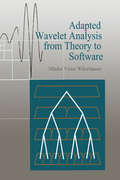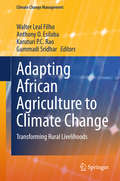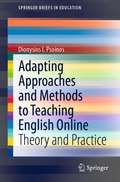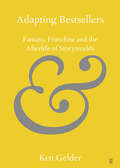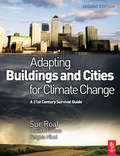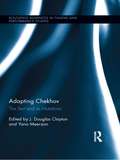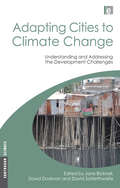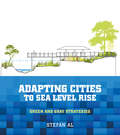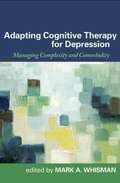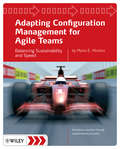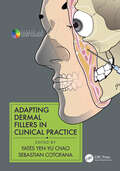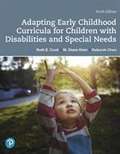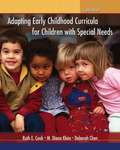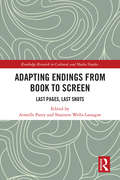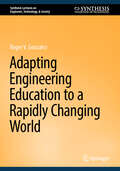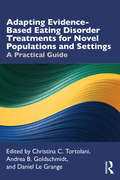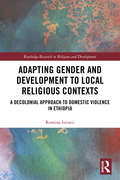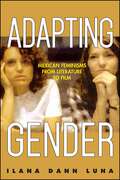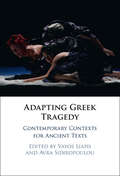- Table View
- List View
Adapted Wavelet Analysis: From Theory to Software
by Mladen Victor WickerhauserThis detail-oriented text is intended for engineers and applied mathematicians who must write computer programs to perform wavelet and related analysis on real data. It contains an overview of mathematical prerequisites and proceeds to describe hands-on programming techniques to implement special programs for signal analysis and other applications.
Adapting African Agriculture to Climate Change: Transforming Rural Livelihoods (Climate Change Management)
by Walter Leal Filho Anthony O. Esilaba Karuturi P. C. Rao Gummadi SridharThis book summarizes the evidence from different African countries about the local impacts of climate change, and how farmers are coping with current climate risks. The different contributors show how agricultural systems in developing countries are affected by climate changes and how communities prepare and adapt to these changes.
Adapting Agricultural Extension to Peacebuilding: Roundtable on Technology, Science, and Peacebuilding
by Andrew RobertsonSocieties have sought to improve the outputs of their agricultural producers for thousands of years. In the 19th and early 20th centuries, efforts to convey agricultural knowledge to farmers became known as extension services, a term adopted from programs at Oxford and Cambridge designed to extend the knowledge generated at universities to surrounding communities. Traditionally, extension services have emphasized a top-down model of technology transfer that encourages and teaches producers to use crop and livestock varieties and agricultural practices that will increase food production. More recently, extension services have moved toward a facilitation model, in which extension agents work with producers to identify their needs and the best sources of expertise to help meet those needs. On May 1, 2012, the Roundtable on Science, Technology, and Peacebuilding held a workshop in Washington, DC, to explore whether and how extension activities could serve peacebuilding purposes. The Roundtable is a partnership between the National Academy of Engineering (NAE) and the U. S. Institute of Peace (USIP). It consists of senior executives and experts from leading governmental organizations, universities, corporations, and nongovernmental organizations, was established in 2011 to make a measurable and positive impact on conflict management, peacebuilding, and security capabilities. Its principal goals are: To accelerate the application of science and technology to the process of peacebuilding and stabilization; To promote systematic, high-level communication between peacebuilding and technical organizations on the problems faced and the technical capabilities required for successful peacebuilding; and To collaborate in applying new science and technology to the most pressing challenges for local and international peacebuilders working in conflict zones.
Adapting Approaches and Methods to Teaching English Online: Theory and Practice (SpringerBriefs in Education)
by Dionysios I. PsoinosThis book provides a framework for synchronous and asynchronous online language teaching. It elaborates on the key features of an online teaching setting, including the instructional media that are involved in it, their affordances and limitations, and recommends ways to adapt pedagogy to suit the online environment. To this end, the book draws on well-established language teaching methods that have been widely used in the physical classroom and puts them to the test by applying them online. This results in the emergence of an e-clectic approach that enables language teachers to be flexible and intentional in their online classroom-related decisions and combines good practices that cut across the broader methodological spectrum with personal teaching preferences, teaching style, and stakeholders’ specifications always considering the capabilities of the setting and the tools currently available to teachers and learners. The book enables teachers to be critical and reflective of their own online teaching practices and equips them, via analysis of live online language sessions, with the necessary skills to confidently engage with screen layout. It also addresses the prominent issue of adapting teacher and learner identity in the online context, and examines their respective roles in online language sessions in a holistic way, offering guidance and support for the practicing online language teacher.
Adapting Bestsellers: Fantasy, Franchise and the Afterlife of Storyworlds (Elements in Publishing and Book Culture)
by Ken GelderThis Element looks at adaptations of bestselling works of popular fiction to cinema, television, stage, radio, video games and other media platforms. It focuses on 'transmedia storytelling', building its case studies around the genre of modern fantasy: because the elaborate storyworlds produced by writers like J. R. R. Tolkien, J. K. Rowling and George R. R. Martin have readily lent themselves to adaptations across various media platforms. This has also made it possible for media entertainment corporations to invest in them over the long term, enabling the development of franchises through which their storyworlds are presented and marketed in new ways to new audiences.
Adapting Buildings and Cities for Climate Change: A 21st Century Survival Guide
by Fergus Nicol Sue Roaf David CrichtonFrom the bestselling author of Ecohouse, this fully revised edition of Adapting Buildings and Cities for Climate Change provides unique insights into how we can protect our buildings, cities, infra-structures and lifestyles against risks associated with extreme weather and related social, economic and energy events. Three new chapters present evidence of escalating rates of environmental change. The authors explore the growing urgency for mitigation and adaptation responses that deal with the resulting challenges. Theoretical information sits alongside practical design guidelines, so architects, designers and planners can not only see clearly what problems they face, but also find the solutions they need, in order to respond to power and water supply needs. Considers use of materials, structures, site issues and planning in order to provide design solutions. Examines recent climate events in the US and UK and looks at how architecture was successful or not in preventing building damage. Adapting Buildings and Cities for Climate Change is an essential source, not just for architects, engineers and planners facing the challenges of designing our building for a changing climate, but also for everyone involved in their production and use.
Adapting Buildings for Changing Uses: Guidelines for Change of Use Refurbishment
by David KincaidAdapting Building for Changing Uses discusses the comprehensive refurbishment of buildings to enable them to be used for purposes different to those originally intended.For those involved in the often risky business of conversion of buildings from one type of use to another, Adapting Building for Changing Uses provides secure guidance on which uses may be best suited to a particular location. This guidance is based on a unique decision tool, the "Use Comparator", which was developed through research carried out at UCL in the mid 1990's. The "Use Comparator" compares the physical and locational characteristics of a building with the characteristics best suited to various types of use. A total of 77 targeted types of use are evaluated, in contrast to the 17 uses normally considers by regulatory planners.Adapting Building for Changing Uses also identifies the key problems experienced by building managers involved in assembling the coalition of Producers, Investors, Marketeers, Regulators and Users, which makes the key decisions in "Adaptive Reuse". The book explores the differing perceptions and attitudes of these key decision agents to matters such as cost, value, risk and robustness, and offers advice on how to avoid the potential for project failure that these differences present.
Adapting Chekhov: The Text and its Mutations (Routledge Advances in Theatre & Performance Studies #23)
by Yana Meerzon J. Douglas ClaytonThis book considers the hundred years of re-writes of Anton Chekhov’s work, presenting a wide geographical landscape of Chekhovian influences in drama. The volume examines the elusive quality of Chekhov’s dramatic universe as an intricate mechanism, an engine in which his enigmatic characters exist as the dramatic and psychological ciphers we have been de-coding for a century, and continue to do so. Examining the practice and the theory of dramatic adaptation both as intermedial transformation (from page to stage) and as intramedial mutation, from page to page, the book presents adaptation as the emerging genre of drama, theatre, and film. This trend marks the performative and social practices of the new millennium, highlighting our epoch’s need to engage with the history of dramatic forms and their evolution. The collection demonstrates that adaptation as the practice of transformation and as a re-thinking of habitual dramatic norms and genre definitions leads to the rejuvenation of existing dramatic and performative standards, pioneering the creation of new traditions and expectations. As the major mode of the storytelling imagination, adaptation can build upon and drive the audience’s horizons of expectations in theatre aesthetics. Hence, this volume investigates the original and transformative knowledge that the story of Chekhov’s drama in mutations offers to scholars of drama and performance, to students of modern literatures and cultures, and to theatre practitioners worldwide.
Adapting Cities to Climate Change: Understanding and Addressing the Development Challenges (Earthscan Climate Ser.)
by David Satterthwaite David Dodman Jane BicknellThis volume brings together, for the first time, a wide-ranging and detailed body of information identifying and assessing risk, vulnerability and adaptation to climate change in urban centres in low- and middle-income countries. Framed by an overview of the main possibilities and constraints for adaptation, the contributors examine the implications of climate change for cities in Africa, Asia and Latin America, and propose innovative agendas for adaptation. The book should be of interest to policy makers, practitioners and academics who face the challenge of addressing climate change vulnerability and adaptation in urban centres throughout the global South. Published with E&U and International Institute for Environment and Development
Adapting Cities to Sea Level Rise: Green and Gray Strategies
by Stefan Al Edgar WesterhofAs cities build more flood-management infrastructure to adapt to the effects of a changing climate, they must go beyond short-term flood protection and consider the long-term effects on the community, its environment, economy, and relationship with the water.Adapting Cities to Sea Level Rise, by infrastructure expert Stefan Al, introduces design responses to sea-level rise, drawing from examples around the globe. Going against standard engineering solutions, Al argues for approaches that are integrated with the public realm, nature-based, and sensitive to local conditions and the community. He features design responses to building resilience that creates new civic assets for cities.With the right solution, Al shows, sea-level rise can become an opportunity to improve our urban areas and landscapes, rather than a threat to our communities.
Adapting Cities to Sea Level Rise: Green and Gray Strategies
by Stefan AlIn 2012, Hurricane Sandy floods devastated coastal areas in New York and New Jersey. In 2017, Harvey flooded Houston. Today in Miami, even on sunny days, king tides bring fish swimming through the streets in low-lying areas. These types of events are typically called natural disasters. But overwhelming scientific consensus says they are actually the result of human-induced climate change and irresponsible construction inside floodplains.As cities build more flood-management infrastructure to adapt to the effects of a changing climate, they must go beyond short-term flood protection and consider the long-term effects on the community, its environment, economy, and relationship with the water. Adapting Cities to Sea Level Rise, by infrastructure expert Stefan Al, introduces design responses to sea-level rise, drawing from examples around the globe. Going against standard engineering solutions, Al argues for approaches that are integrated with the public realm, nature-based, and sensitive to local conditions and the community. He features design responses to building resilience that creates new civic assets for cities. For the first time, the possible infrastructure solutions are brought together in a clear and easy-to-read format.The first part of the book looks at the challenges for cities that have historically faced sea-level rise and flooding issues, and their response in resiliency through urban design. He presents diverse case studies from New Orleans to Ho Chi Minh to Rotterdam, and draws best practices and urban design typologies for the second part of the book. Part two is a graphic catalogue of best-practices or resilience strategies. These strategies are organized into four categories: hard protect, soft protect, store, and retreat. The benefits and challenges of each strategy are outlined and highlighted by a case study showing where that strategy has been applied.Any professional or policymaker in coastal areas seeking to protect their communities from the effects of climate change should start with this book. With the right solutions, Al shows, sea-level rise can become an opportunity to improve our urban areas and landscapes, rather than a threat to our communities.
Adapting Cognitive Therapy for Depression
by Mark WhismanWhile the efficacy of cognitive therapy for depression is well established, every clinician is likely to encounter patients who do not respond to "standard" protocols. In this highly practical volume, leading authorities provide a unified set of clinical guidelines for conceptualizing, assessing, and treating challenging presentations of depression. Presented are detailed, flexible strategies for addressing severe, chronic, partially remitted, or recurrent depression, as well as psychiatric comorbidities, medical conditions, and family problems that may complicate treatment. The book also offers essential knowledge and tools for delivering competent care to specific populations of depressed patients ethnic minorities; lesbian, gay, and bisexual people; adolescents; and older adults.
Adapting Configuration Management for Agile Teams
by Mario E. MoreiraAdapting Configuration Management for Agile Teams provides very tangible approaches on how Configuration Management with its practices and infrastructure can be adapted and managed in order to directly benefit agile teams. Written by Mario E. Moreira, author of Software Configuration Management Implementation Roadmap, columnist for CM Crossroads online community and writer for the Agile Journal, this unique book provides concrete guidance on tailoring CM for Agile projects without sacrificing the principles of Configuration Management.
Adapting Dermal Fillers in Clinical Practice (Series in Cosmetic and Laser Therapy)
by Yates Yen-Yu ChaoThere have been many different brands of dermal fillers approved for use for soft tissue augmentation in the US market alone, comprising four different types of temporary fillers and one permanent type, with several other brands and types also available elsewhere in the world. Against such a potentially bewildering variety and range of choices, this new text offers a scientific and an anatomic rationale for why a particular filler should be selected as optimal for each individual location and indication and how it should best be used in treatments. International experts share their clinical knowledge and expertise to guide all levels of esthetic practitioners toward the best results for each individual patient. CONTENTS: Fundamentals of Injectable Filler Procedures * Basic Injection Techniques * Modified and Advanced Injection Techniques * Novel Injection Techniques * Esthetic Filler Injection Pearls * Adapting Injection Techniques to Different Regions * Adapting Injection Techniques to Special Indications * Adapting Injection Techniques to Different Filling Materials * Adapting Injection Techniques to Different Genders * Adapting Injection Techniques to Different Age Groups * Adapting Injection Techniques to Patients of Different Ethnicity * Prevention and Management of Complications.
Adapting Early Childhood Curricula For Children With Special Needs
by Deborah Chen Ruth Cook M. KleinAdapting Early Childhood Curricula for Children with Disabilities and Special Needs uses a developmental focus, rather than a disability orientation, to discuss typical and atypical child development and curricular adaptations. The integrated, non-categorical approach assumes that children are more alike than different in their development. The inclusive focus assumes that attitudes, environments, and intervention strategies can be adapted so that all young children with disabilities or other special needs can be included. <p><p> An essential text for today, and a valuable resource to take into the classroom tomorrow, this practical guide provides daily activities, evidence-based how-to strategies, and realistic lesson modifications that help facilitate truly inclusive classrooms. Aspiring educators will also learn to develop their collaboration and problem-solving skills to effectively work with families, colleagues, and paraprofessionals in supporting every child's positive development. <p> The 10th Edition is updated to include enhanced discussions on working with families, children, and professionals of diverse cultural and linguistic backgrounds and lifestyles; new tips for integrating Division for Early Childhood Recommended Practices; updated requirements for writing IEP goals and recommendations; and more.
Adapting Early Childhood Curricula for Children with Special Needs (Eighth Edition)
by Deborah Chen Ruth E. Cook M. Diane KleinThe book focuses on a blend of developmental and learning theories, with practical suggestions for delivery of services to young children with special needs and their families.
Adapting Educational and Psychological Tests for Cross-Cultural Assessment
by Ronald K. Hambleton Charles D. Spielberger Peter F. MerendaAdapting Educational and Psychological Tests for Cross-Cultural Assessment critically examines and advances new methods and practices for adapting tests for cross-cultural assessment and research. The International Test Commission (ITC) guidelines for test adaptation and conceptual and methodological issues in test adaptation are described in detail, and questions of ethics and concern for validity of test scores in cross-cultural contexts are carefully examined. Advances in test translation and adaptation methodology, including statistical identification of flawed test items, establishing equivalence of different language versions of a test, and methodologies for comparing tests in multiple languages, are reviewed and evaluated. The book also focuses on adapting ability, achievement, and personality tests for cross-cultural assessment in educational, industrial, and clinical settings. This book furthers the ITC's mission of stimulating research on timely topics associated with assessment. It provides an excellent resource for courses in psychometric methods, test construction, and educational and/or psychological assessment, testing, and measurement. Written by internationally known scholars in psychometric methods and cross-cultural psychology, the collection of chapters should also provide essential information for educators and psychologists involved in cross-cultural assessment, as well as students aspiring to such careers.
Adapting Endings from Book to Screen: Last Pages, Last Shots (Routledge Research in Cultural and Media Studies)
by Armelle Parey Shannon Wells-LassagneThis book offers a new perspective on adaptation of books to the screen; by focusing on endings, new light is shed on this key facet of film and television studies. The authors look at a broad range of case studies from different genres, eras, countries and formats to analyse literary and cinematic traditions, technical considerations and ideological issues involved in film and television adaptions. The investigation covers both the ideological implications of changes made in adapting the final pages to the screen, as well as the aesthetic stance taken in modifying (or on the contrary, maintaining) the ending of the source text. By including writings on both film and television adaptations, this book examines the array of possibilities for the closure of an adapted narrative, focusing both on the specificities of film and different television forms (miniseries and ongoing television narratives) and at the same time suggesting the commonalities of these audiovisual forms in their closing moments. Adapting Endings from Book to Screen will be of interest to all scholars working in media studies, film and television studies, and adaptation studies.
Adapting Engineering Education to a Rapidly Changing World (Synthesis Lectures on Engineers, Technology, & Society)
by Roger V. GonzalezRapid technological advancements, globalization, and environmental concerns impact the role of engineers in today’s society. The book emphasizes the role and contribution of engineers to society, and the importance of engineering education. However, to better prepare engineers, for the challenges and opportunities of their profession, engineering education must change. This book begins by comparing the systems of engineering education in the United States and the United Kingdom, in terms of program structure, students, academics/faculty, and external factors. This comparison provides context to the discussion of the leadership role engineers should play and how engineering education should prepare students for leadership. The focus of the second part of the book is on the important role of professional development in engineering education and on broadening access to and participation in these programs. The author explains that engineering education programs must be redesigned to meet industry needs and to allow future engineers to achieve career success. To do so, in addition to traditional topics in science and engineering, programs should help students develop professional and managerial skills including communication, project management, analytical, and problem-solving skills. The final part of the book is dedicated to exploring how accelerated technological developments including artificial intelligence, require that engineering programs adapt, in order to remain relevant.
Adapting Evidence-Based Eating Disorder Treatments for Novel Populations and Settings: A Practical Guide (A\hodder Arnold Publication)
by Basant K. Puri David Enoch Hadrian BallThis comprehensive text provides practical approaches to adapting empirically supported treatments for eating disorders for clinicians working with patients of diverse backgrounds and presentations, or within non-traditional treatment settings across levels of care. The book describes empirically- and clinically-informed treatment adaptations that impact delivery of real-world services for eating disorder patients and generate interest in testing adapted treatments in randomized controlled trials. Featuring contributions from researchers and clinicians with expertise in developing, delivering, and testing interventions for eating disorders, each chapter focuses on a specific population, setting, or training approach. Practical applications are then illustrated through case examples and wisdom gleaned through the contributors’ own clinical studies and experiences. Readers working with a diverse population of eating disorder patients will gain the necessary skills to support their patients on the journey to recovery and self-acceptance.
Adapting Gender and Development to Local Religious Contexts: A Decolonial Approach to Domestic Violence in Ethiopia (Routledge Research in Religion and Development)
by Romina IstratiiThis book provides a critical and decolonial analysis of gender and development theory and practice in religious societies through the presentation of a detailed ethnographic study of conjugal violence in Ethiopia. Responding to recent consensus that gender mainstreaming approaches have failed to produce their intended structural changes, Romina Istratii explains that gender and development analytical and theoretical frameworks are often constructed through western Euro-centric lenses ill-equipped to understand gender-related realities and human behaviour in non-western religious contexts and knowledge systems. Instead, Istratii argues for an approach to gender-sensitive research and practice which is embedded in insiders’ conceptual understandings as a basis to theorise about gender, assess the possible gendered underpinnings of local issues and design appropriate alleviation strategies. Drawing on a detailed study of conjugal abuse realities and attitudes in two villages and the city of Aksum in Northern Ethiopia, she demonstrates how religious knowledge can be engaged in the design and implementation of remedial interventions. This book carefully evidences the importance of integrating religious traditions and spirituality in current discussions of sustainable development in Africa, and speaks to researchers and practitioners of gender, religion and development in Africa, scholars of non-western Christianities and Ethiopian studies, and domestic violence researchers and practitioners.
Adapting Gender: Mexican Feminisms from Literature to Film (SUNY series in Latin American Cinema)
by Ilana Dann LunaAdapting Gender offers a cogent introduction to Mexico's film industry, the history of women's filmmaking in Mexico, a new approach to adaptation as a potential feminist strategy, and a cultural history of generational changes in Mexico. Ilana Dann Luna examines how adapted films have the potential to subvert not only the intentions of the source text, but how they can also interrupt the hegemony of gender stereotypes in a broader socio-political context. Luna follows the industrial shifts that began with Salinas de Gortari's presidency, which made the long 1990s the precise moment in which subversive filmmakers, particularly women, were able to participate more fully in the industry and portrayed the lived experiences of women and non-gender-conforming men. The analysis focuses on Busi Cortés's El secreto de Romelia (1988), an adaptation of Rosario Castellanos's short novel El viudo Román (1964); Sabina Berman and Isabelle Tardán's Entre Pancho Villa y una mujer desnuda (1996), an adaptation of Berman's own play, Entre Villa y una mujer desnuda (1992); Guita Schyfter's Novia que te vea (1993), an adaptation of Rosa Nissán's eponymous novel (1992); and Jaime Humberto Hermosillo's De noche vienes, Esmeralda (1997), an adaptation of Elena Poniatowska's short story "De noche vienes" (1979). These adapted texts established a significant alternative to monolithic notions of national (gendered) identity, while critiquing, updating, and even queering, notions of feminism in the Mexican context.
Adapting Greek Tragedy: Contemporary Contexts for Ancient Texts
by Avra Sidiropoulou Vayos LiapisAdaptations of Greek tragedy are increasingly claiming our attention as a dynamic way of engaging with a dramatic genre that flourished in Greece some twenty-five centuries ago but remains as vital as ever. In this volume, fifteen leading scholars and practitioners of the theatre systematically discuss contemporary adaptations of Greek tragedy and explore the challenges and rewards involved therein. Adopting a variety of methodologies, viewpoints and approaches, the volume offers surveys of recent developments in the field, engages with challenging theoretical issues, and shows how adapting Greek tragedy can throw new light on a range of contemporary issues — from our relation to the classical past and our shifting perceptions of ethnic and cultural identities to the place, function and market-value of Greek drama in today's cultural industries. The volume will be welcomed by students and scholars in Classics, Theatre, Drama and Performance Studies, as well as by theatre practitioners.
Adapting Higher Education Teaching for an Online Environment: A practical guide
by Rachel Stone Ian GloverFor busy academics of all subject disciplines who have been asked to convert their face to face teaching into an online model of delivery. The chapters present the steps that need to be taken to design and facilitate a high quality learning experience for students using a variety of modes and media. Each chapter includes a task and a checklist designed to help the reader through the transition process, covering such aspects as tools, structure, presentations, live and ‘on demand’ teaching, assessment, ideas for activities, inclusion and trouble-shooting.
Adapting Higher Education Teaching for an Online Environment: A practical guide
by Rachel Stone Ian GloverFor busy academics of all subject disciplines who have been asked to convert their face to face teaching into an online model of delivery. The chapters present the steps that need to be taken to design and facilitate a high quality learning experience for students using a variety of modes and media. Each chapter includes a task and a checklist designed to help the reader through the transition process, covering such aspects as tools, structure, presentations, live and ‘on demand’ teaching, assessment, ideas for activities, inclusion and trouble-shooting.
